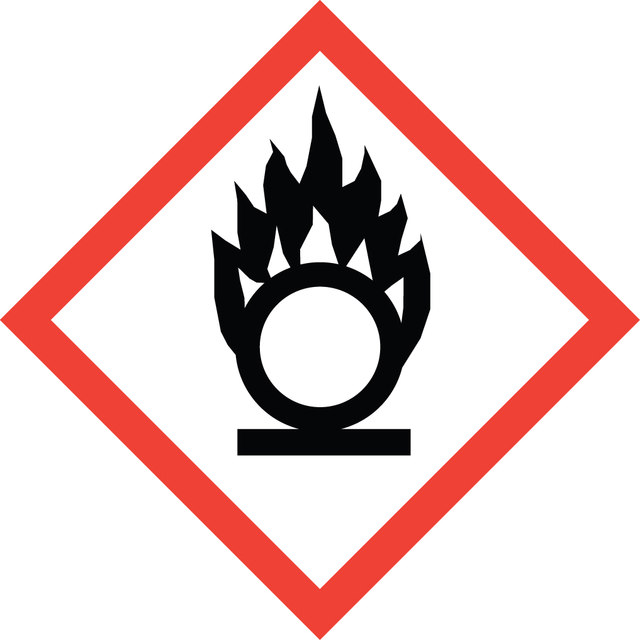Select a Size
About This Item
Product Name
Perchloric acid 70-72%, for analysis EMSURE® ACS,ISO,Reag. Ph Eur
SMILES string
OCl(=O)(=O)=O
InChI
1S/ClHO4/c2-1(3,4)5/h(H,2,3,4,5)
InChI key
VLTRZXGMWDSKGL-UHFFFAOYSA-N
grade
ACS reagent
agency
reag. ISO
reag. Ph. Eur.
product line
EMSURE®
form
liquid
concentration
70.0-72.0% HClO4
impurities
≤0.02 ppm Ba (Barium)
≤0.02 ppm Be (Beryllium)
≤0.02 ppm Li (Lithium)
≤0.02 ppm Mn (Manganese)
≤0.02 ppm Sr (Strontium)
≤0.05 ppm Al (Aluminium)
≤0.05 ppm As (Arsenic)
≤0.05 ppm Cd (Cadmium)
≤0.05 ppm Co (Cobalt)
≤0.05 ppm Ge (Germanium)
≤0.05 ppm Mo (Molybdenum)
≤0.05 ppm Pb (Lead)
≤0.05 ppm Tl (Thallium)
≤0.05 ppm V (Vanadium)
≤0.1 ppm Ag (Silver)
≤0.1 ppm Bi (Bismuth)
≤0.1 ppm Cu (Copper)
≤0.1 ppm K (Potassium)
≤0.1 ppm Ni (Nickel)
≤0.1 ppm Ti (Titanium)
≤0.1 ppm Zn (Zinc)
≤0.1 ppm Zr (Zirconium)
≤0.5 ppm Ca (Calcium)
≤0.5 ppm Free chlorine (Cl)
≤0.5 ppm Mg (Magnesium)
≤0.5 ppm Na (Sodium)
≤1 ppm Heavy metals (as Pb)
≤1.0 ppm Fe (Iron)
≤10 ppm Chlorate (ClO3)
≤10 ppm Sulfate (SO4)
≤10 ppm Total nitrogen (N)
≤3 ppm Chloride (Cl)
≤5 ppm Phosphate and Silicate (as SiO2)
ign. residue
≤0.003% (as sulfate)
color
APHA: ≤10
bp
198.7 °C/1013 hPa
mp
-18 °C
solubility
water: soluble
density
1.68 g/cm3 at 20 °C
storage temp.
15-25°C
Quality Level
Looking for similar products? Visit Product Comparison Guide
Related Categories
Analysis Note
Identity: passes test
Density (d 20/20): approx. 1.7
Color: ≤ 10 Hazen
Chlorate (ClO₃): ≤ 10 ppm
Chloride (Cl): ≤ 3 ppm
Free chlorine (Cl): ≤ 0.5 ppm
Phosphate and Silicate (as SiO₂): ≤ 5 ppm
Sulfate (SO₄): ≤ 10 ppm
Total nitrogen (N): ≤ 10 ppm
Heavy metals (as Pb): ≤ 1 ppm
Ag (Silver): ≤ 0.1 ppm
Al (Aluminium): ≤ 0.05 ppm
As (Arsenic): ≤ 0.05 ppm
Ba (Barium): ≤ 0.02 ppm
Be (Beryllium): ≤ 0.02 ppm
Bi (Bismuth): ≤ 0.1 ppm
Ca (Calcium): ≤ 0.5 ppm
Cd (Cadmium): ≤ 0.05 ppm
Co (Cobalt): ≤ 0.05 ppm
Cu (Copper): ≤ 0.1 ppm
Fe (Iron): ≤ 1.0 ppm
Ge (Germanium): ≤ 0.05 ppm
K (Potassium): ≤ 0.1 ppm
Li (Lithium): ≤ 0.02 ppm
Mg (Magnesium): ≤ 0.5 ppm
Mn (Manganese): ≤ 0.02 ppm
Mo (Molybdenum): ≤ 0.05 ppm
Na (Sodium): ≤ 0.5 ppm
Ni (Nickel): ≤ 0.1 ppm
Pb (Lead): ≤ 0.05 ppm
Sr (Strontium): ≤ 0.02 ppm
Ti (Titanium): ≤ 0.1 ppm
Tl (Thallium): ≤ 0.05 ppm
V (Vanadium): ≤ 0.05 ppm
Zn (Zinc): ≤ 0.1 ppm
Zr (Zirconium): ≤ 0.1 ppm
Residue on ignition (as sulfate): ≤ 0.003 %
conforms to ACS, ISO, Reag. Ph Eur
Application
- Optimization of selenylation modification for garlic polysaccharide based on immune-enhancing activity: This study explored the optimization process for the selenylation of garlic polysaccharides, aiming to enhance their immune-boosting properties. Perchloric acid played a role in the preparation phase, facilitating the modification of polysaccharides to achieve better bioactivity (Gao et al., 2016).
- Synthesis and Characterization of Isodiphenylfluorindone and Isodiphenylfluorindinone: Research focused on the synthesis of novel fluorinated compounds, where perchloric acid was utilized as a catalyst to promote the formation of these complex molecules, highlighting its utility in synthetic organic chemistry (Zissimou et al., 2018).
- Cocrystallization of photosensitive energetic copper(II) perchlorate complexes: Perchloric acid derivatives were studied for their potential in creating stable, photosensitive materials suitable for energetic applications, demonstrating the acid′s versatility in materials science (Evers et al., 2014).
- Early molecular oxidative stress biomarkers of ischemic penumbra in acute stroke: The study involves the use of perchloric acid in the extraction and stabilization of biomarkers from biological samples, essential for the accurate diagnosis and treatment of stroke (Lorenzano et al., 2019).
- An improved, high-efficiency assay for assessing serum anticholinergic activity: This research developed a novel assay method using perchloric acid to extract and quantify anticholinergic activity from serum samples, offering advancements in pharmacological studies (Nobrega et al., 2017).
Legal Information
signalword
Danger
hcodes
Hazard Classifications
Acute Tox. 4 Oral - Eye Dam. 1 - Met. Corr. 1 - Ox. Liq. 1 - Skin Corr. 1A - STOT RE 2
target_organs
Thyroid
Storage Class
5.1A - Strongly oxidizing hazardous materials
wgk
WGK 1
flash_point_f
Not applicable
flash_point_c
Not applicable
Regulatory Information
Certificates of Analysis (COA)
Search for Certificates of Analysis (COA) by entering the products Lot/Batch Number. Lot and Batch Numbers can be found on a product’s label following the words ‘Lot’ or ‘Batch’.
Already Own This Product?
Find documentation for the products that you have recently purchased in the Document Library.
Articles
EMSURE® Grade Inorganic Solvents and Reagents offer exceptional purity and quality control, ensuring reliable, compliant results for regulated analyses.
Acid and base chart lists the strength of acids and bases (strongest to weakest) in order. Simple to use laboratory reference chart for scientists, researchers and lab technicians.
Photometric assessment of bromate in drinking water samples using Spectroquant® photometer and test kits, along with 3,3'-dimethylnaphthidine and potassium iodide.
Protocols
The iron test enables quantification of iron ions in various waters. Iron ions are reduced to iron(II) ions that react with a triazine derivative to form a red-violet complex that is measured photometrically.
Related Content
Glass bottles are ideal for storing acids because they are inert and offer a long shelf life.
Our team of scientists has experience in all areas of research including Life Science, Material Science, Chemical Synthesis, Chromatography, Analytical and many others.
Contact Technical Service


